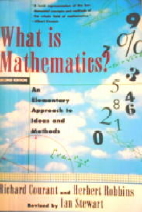The Riemann Hypothesis came to my attention again recently. More specifically I read a bit about the possibility that quantum mechanical measurements may provide a proof of a centuries-old hypothesis and one of mathematics’ most famous enigmas.

Within mathematics itself, without any reference to its physical meaning, the Riemann Hypothesis highlights the kind of surprises that the very notion of number itself has produced. Riemann saw a connection between a particular function of a complex variable, and the distribution of prime numbers (numbers evenly divisible by only themselves and 1). These numbers, like 2, 3, 5, 7, 11, 13, … are found among the infinite set of natural numbers. The function somehow associates information about the prime numbers (which emerge from one of the simplest arithmetic ideas) with a function that describes a relation among complex numbers. Complex numbers are represented by the sum of a real number and an imaginary number. The imaginary part of the number is a multiple of the imaginary unit i, defined as the square root of -1. The function is a zeta function, in particular it is the Riemann zeta function. It is an infinite sum (first introduced as a function of real variables by Leonhard Euler in the 18th century) whose terms are given by
![]()
Riemann extended Euler’s idea by letting n be a complex number. With the tools of complex analysis, he found a relationship between the zeros of the zeta function, ( the n values that produced zeros) and the distribution of prime numbers. It then became possible to use these zeros to count prime numbers and to get information about their positions with respect to the natural numbers as well as to each other. Riemann discovered a formula for calculating the number of primes below a given number. It only works, however, when the real part of those complex numbers that produce zeros is 1/2. While it continues to look like the real part of all of these zeros is 1/2, there is no proof that this generalization is true. Improvements in computing programs have nonetheless made it possible to determine that it is true for at least the first 10 trillion zeros.
I should add that the Riemann zeta function fits into an intellectual weave that includes a number of other functions – ones that express related ideas or that produce specified values. This kind of close investigation of ideas, that culminates in so much mathematics, is fundamentally fueled by little more than what functions can reveal about numbers and vice versa. There are so many intriguing things about the multitude of unexpected results produced by these purely abstract investigations. Yet the nature of this wholly symbolic exploration rarely shows up in discussions of science in general, or of cognition and epistemology in particular. When we dig further into the world of numbers and their relations, (and find so much!) what are we actually looking at? Whether we’re looking at our ourselves or at an ideal world that is inaccessible to our senses, it is equally remarkable that we can see it at all. I feel strongly that mathematics is particularly fertile ground for planting epistemological questions.
The Riemann zeta function is known for being able to answer questions about the spacing or distribution of prime numbers. And prime numbers are important to the creation of new encryption algorithms that rely on them. But the zeta function has also found application in the physical side of our experience – in things like quantum statistical mechanics and nuclear physics.
The natural fit that the Riemann zeta function enjoys in physics is even more surprising. On the School of Mathematics website at the University of Bristol is this:
The University of Bristol has been at the forefront of showing that there are striking similarities between the Riemann zeros and the quantum energy levels of classically chaotic systems.
From a conference in 1996 in Seattle, aimed at fostering collaboration between physicists and number theorists, came early evidence of correlation between the arrangement of the Riemann zeroes and the energy levels of quantum chaotic systems. If this were true it would prove the Riemann hypothesis.
This is a reversal of what usually happens. Mathematical discoveries usually contribute to physical discoveries and not the other way around. But observations in physics have moved so far outside the range of the senses that physicists necessarily rely more and more heavily on mathematical structure. The disciplines, are inevitably more and more entangled.
Natalie Wolchover wrote about these efforts in a recent Quanta Magazine article.
As mathematicians have attacked the hypothesis from every angle, the problem has also migrated to physics. Since the 1940s, intriguing hints have arisen of a connection between the zeros of the zeta function and quantum mechanics. For instance, researchers found that the spacing of the zeros exhibits the same statistical pattern as the spectra of atomic energy levels. In 1999, the mathematical physicists Michael Berry and Jonathan Keating, building on an earlier conjecture of David Hilbert and George Pólya, conjectured that there exists a quantum system (that is, a system with a position and a momentum that are related by Heisenberg’s uncertainty principle) whose energy levels exactly correspond to the nontrivial zeros of the Riemann zeta function…
If such a quantum system existed, this would automatically imply the Riemann hypothesis.
Wolchover explains that physicists who have their eye on the prize are exploring quantum systems described by matrices whose eigenvalues correspond to the system’s energy levels. A recent paper in Physical Review Letters, authored by Carl Bender of Washington University in St. Louis, Dorje Brody of Brunel University London and Markus Müller of the University of Western Ontario proposed a candidate system.
If physicists do someday nail down the quantum interpretation of the zeros of the zeta function,… this could provide an even more precise handle on the prime numbers than Riemann’s formula does, since matrix eigenvalues follow very well-understood statistical distributions. It would have other implications as well…
A quantum system that models the distribution of primes might provide a simple model of chaos. This narrative is a nice story about the insightful nature of mathematics – about the way it can see in.


Recent Comments